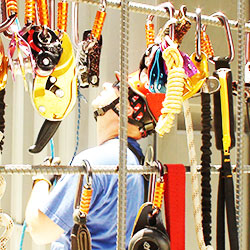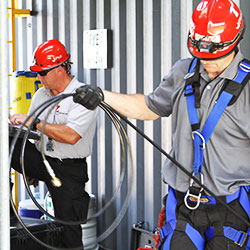Confined Space Rescue…Always Seeking a Better, Safer Way!
 When a student returns to one of our classes after a few years, we’ll often hear, “Wow, things sure have changed! There are a lot of new techniques and equipment since the last time I attended.” So, why do we change our courses on a regular basis? If it worked back then, why change it?
When a student returns to one of our classes after a few years, we’ll often hear, “Wow, things sure have changed! There are a lot of new techniques and equipment since the last time I attended.” So, why do we change our courses on a regular basis? If it worked back then, why change it?
The answer is simple really… if there’s a better way or safer way to do something, we'll take the opportunity to incorporate it into our programs.
When deciding what techniques or equipment may be candidates, we typically look at three primary objectives:
1. Does it perform a function that is needed in order to accomplish the type of rescue that is being addressed?
Once these requirements are met, we'll ask...

When evaluating a new piece of equipment for our programs, we will also consider how versatile the item may be.
To have one piece of equipment that performs multiple functions is a huge benefit to rescuers in that it saves time, money, weight and bulk.
One example of a product that performs multiple functions is the Petzl ID. The ID can be used as the foundation of MA systems, it can also be used for short ascents, and the manufacturer now allows it to be used as a belay device.
Compliance with legislated regulations is also a big consideration. For performance-based regulations like 1910.146 (Permit-Required Confined Spaces), it’s all about creating a competent rescuer who is capable of safely and effectively in permit spaces. Other relevant OSHA regulations include Fall Protection, Respiratory Protection, Lock Out/Tag Out, and HAZMAT, just to name a few. We also refer to many different nationally recognized consensus standards as we build our programs. Probably the most visited we draw from are NFPA 1006 and 1983, which offer guidance on professional qualifications for rescuers and equipment standards for manufacturers. We also rely on ANSI, NATE, SPRAT and IRATA, as well as other standards that provide appropriate guidance for the type of program we are delivering.
But, where do we come up with the leading edge techniques and equipment that we are continuously adding to our courses? Well, this is where we take a lot of pride in how we operate internally as a business.
Roco’s leadership has always encouraged our instructors and rescue personnel to identify needs in the rescue world and think of a way to satisfy that need…yes, to build a better mousetrap!
We want our people to constantly be on the lookout for opportunities to evaluate new equipment or come up with a new technique that meets the three primary objectives that we identified earlier.

As an added benefit, Roco instructors and rescue team members come from a wide variety of backgrounds. This includes the fire service, law enforcement, U.S. military and private sector industrial emergency response teams. What’s more, some of our personnel enjoy sport climbing and even expedition mountaineering on their off time. In other words, we have a very diverse way of putting ropes and associated hardware to the test. Everyone is encouraged to share their ideas.
Oftentimes this "free thinking" among our personnel leads to a great step forward in efficiency and allows us to keep our courses leading the way to a better rescuer.
It’s also exciting to see some of the emerging technologies that have come to market as far as rescue equipment is concerned. By encouraging our personnel to get their hands on these new pieces of kit and “ride them hard,” we are able to determine if it is something that needs to be incorporated into our scheme. Every once in a while, we’ll even discover a new way to use the equipment that is beyond what the manufacturer envisioned. Our people have come up with some very unique ways to meet some very specific rescue needs. But, it all comes back to those same three primary objectives. We need a piece of gear (or a technique) that will do the job we need it to do, and do it safely and efficiently.
Here's a great example...who would have thought that a technique used on glacier crevasse rescue would be a skill that comes in handy in an industrial environment? Fortunately, someone in our think tank did, and now it is a staple of our curricula. So, if it’s been a while since you have attended a Roco class, maybe it’s time to come see what we have been up to lately.
For the ultimate rope rescue experience, click on Roco's Fast-Track 120™




